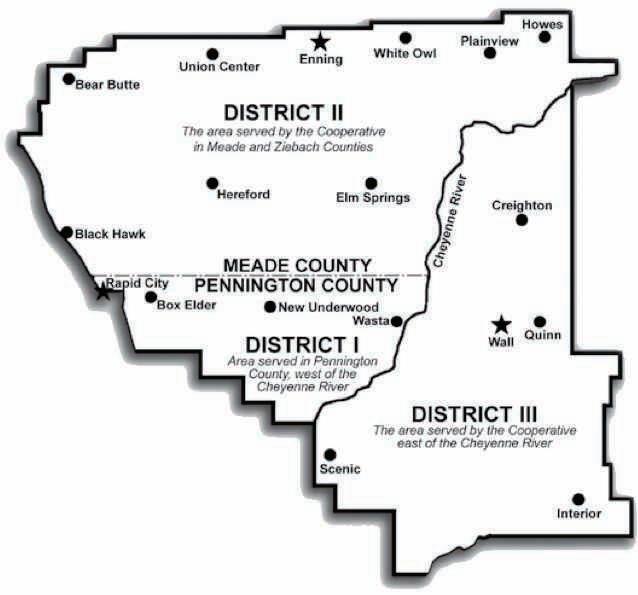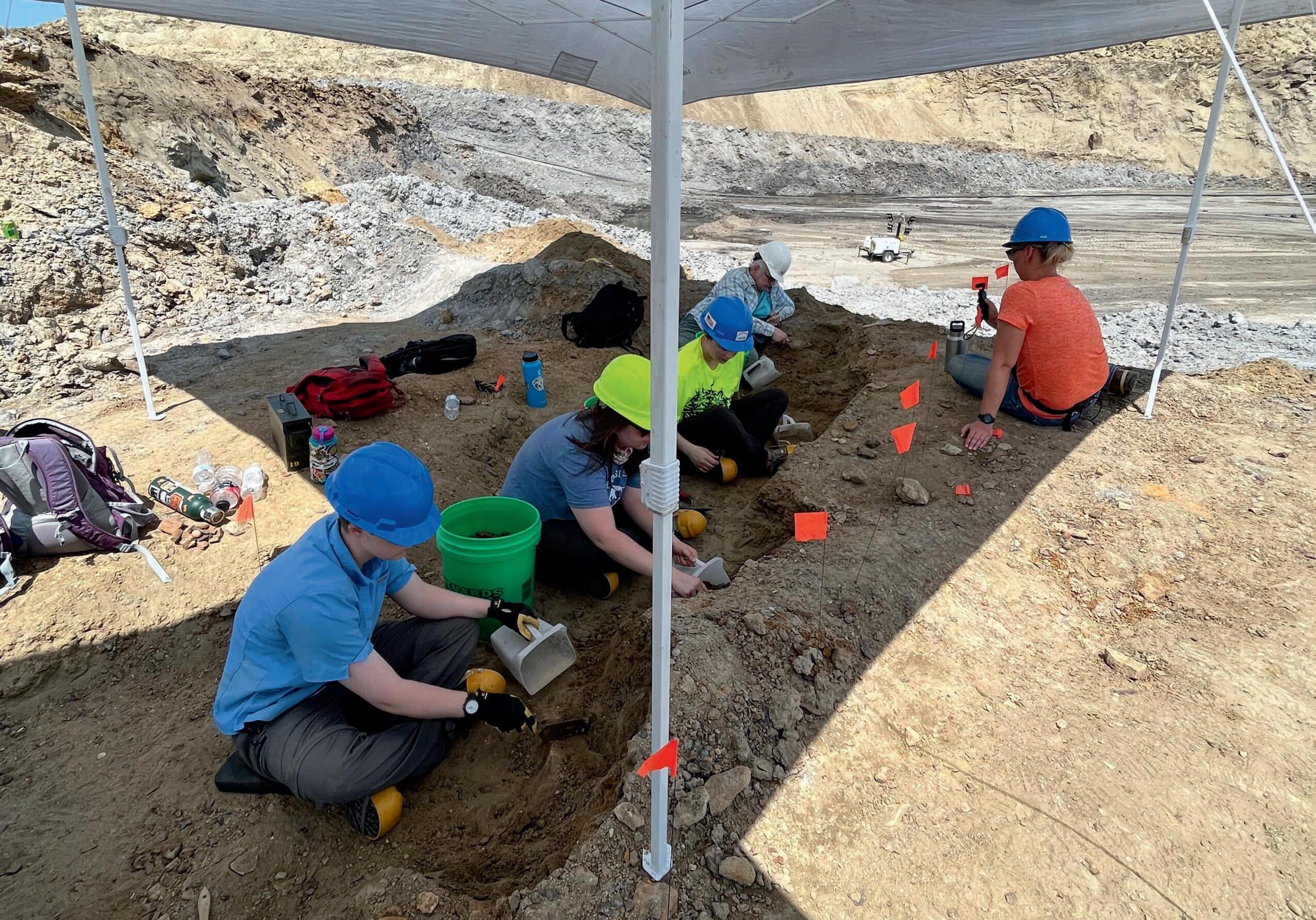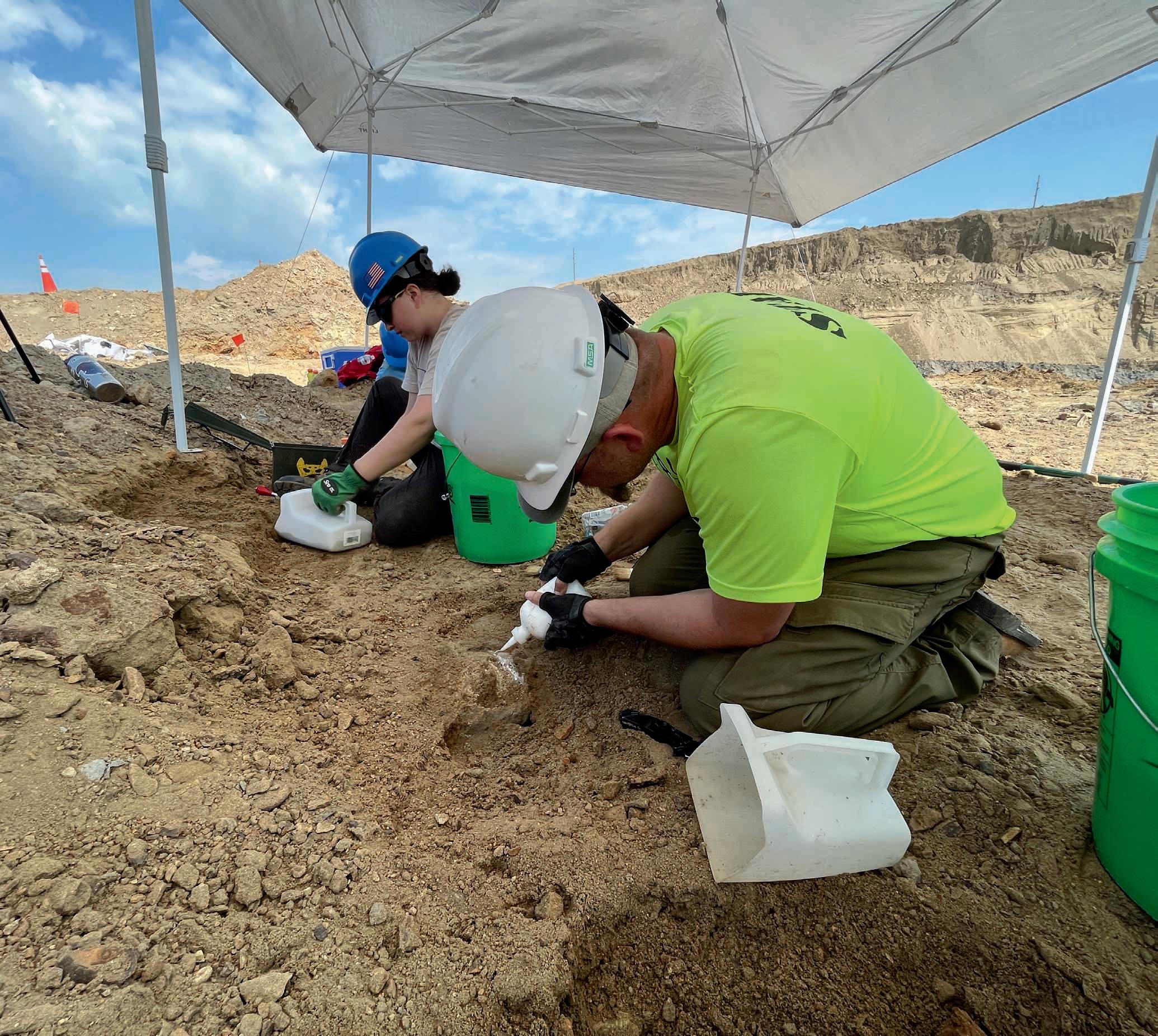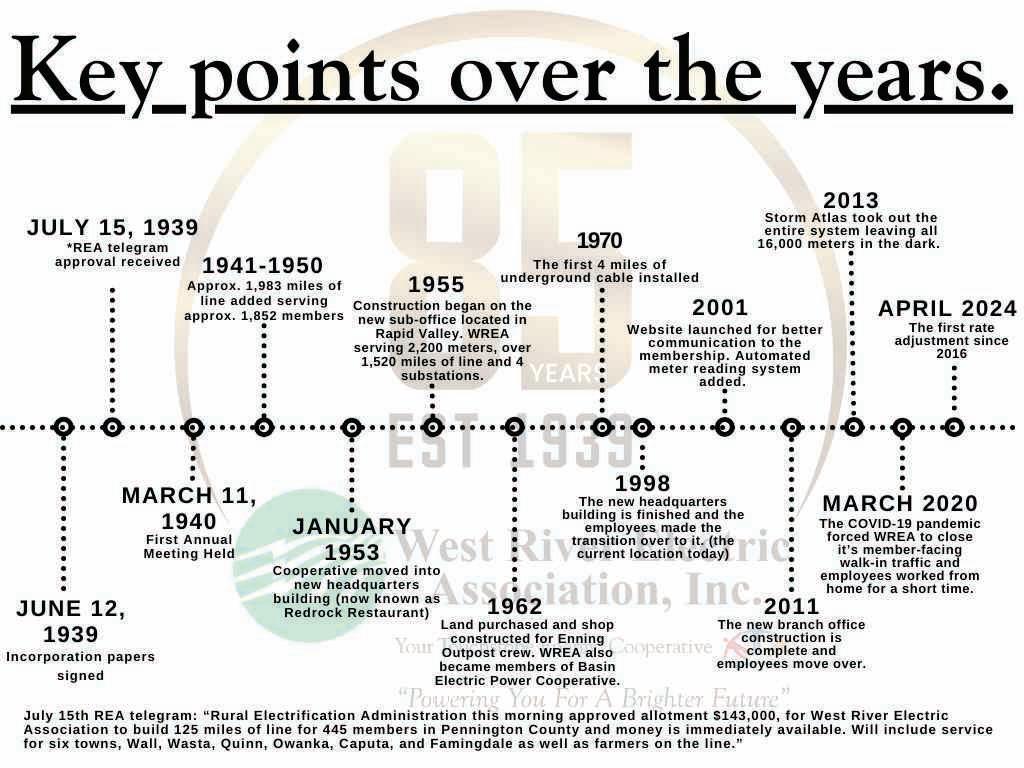




Pages 12-13

Dick Johnson CEO/GM
It is summertime today with hot temperatures and high humidity. I do not mind warm weather, so I will take this anytime compared to anything below 40 degrees. My heart goes out to those east of us that had severe flooding. It is gut wrenching to see the damage the water has done. Most of our sister cooperatives were fortunate not to have large dollars of damage. 3218600
With the warm weather, I think of the value of electricity. I sure enjoy my air conditioning when I come in from the outside. I know not everyone has air conditioning in their homes, but what would our lives be without it. We have all become so accustomed to electricity that many people do not even think twice about the light switch coming on. I feel many people have become so accustomed to electricity they take it for granted just like the air we breathe. When you look at the cost, it is a very inexpensive commodity that you as our members can enjoy, helping to make your life better and our communities stronger. I think many of our members pay more for their cell phone bill than they do for their electricity. Yet they need electricity to charge those same phones.
Besides informing our members of the value of electricity, we work hard to increase sales to new members to help spread fixed costs. I have recently had the opportunity to attend training sessions regarding data centers. Data centers have been around for some time. However, they have taken on an entirely new role in our world with the explosion of artificial intelligence or AI for short. To power AI, large computers are needed to perform all the calculations and algorithms needed to run AI. Large data centers can consume large, I mean
very large, amounts of electricity. They run 24 hours a day 365 days a year. I have one coop colleague who has 1,400 MW of data centers on his system. To put that in perspective 1,400 MW would equate to 1.1 million homes. That is right: approximately 1.1 million homes. That is just one cooperative.
I wonder what a data center would look like for West River and their members. From what I have gleaned from these training courses is they are a lot of work to get set up but return nice margins to help the rest of the membership and stave off large rate increases in the future. These centers also contribute many dollars to the local tax base. There aren’t a large number of full time, permanent jobs with these centers.
The only real downside is that in the future we may not have generation available for these mega-loads. This is an issue around the entire country; how do we continue to provide power to more data centers? Many of these loads can curtail their usage during peak times when generation is short, but how long are they willing to curtail their loads. All the operators of these centers agree wind, solar and battery can’t provide 100% of their needs now.
I bring this up to show how we need more dispatchable 24x7 electricity to power our lives. Electricity is a finite commodity right now. We need more generation available, not intermittent sources like solar and wind but good, clean, reliable, affordable always available generation.
I hope you have a great rest of your summer, and please stay safe!

(USPS No. 675-840)
Our Mission:
To serve our members’ best interest.
Our Vision:
We will be a high performing co-op.
Our Values:
1. Safety 2. Accountability
3. Integrity 4. Innovation
5. Commitment to Community
This institution is an equal opportunity provider and employer.
Board President: Andy Moon
Board of Directors
Stan Anders – Vice President
Jamie Lewis – Secretary
Chuck Sloan – Treasurer
Larry Eisenbraun
Peter Blake
Marcia Arneson
Howard Knuppe
Sue Peters
CEO and General Manager: Dick Johnson –dick.johnson@westriver.coop
Editor
Amanda Haugen –amanda.haugen@westriver.coop
WEST RIVER ELECTRIC COOPERATIVE CONNECTIONS is the monthly publication for the members of West River Electric Association. Members subscribe to Cooperative Connections as part of their electric cooperative membership for $6 a year. West River Electric Cooperative Connections purpose is to provide reliable, helpful information to electric cooperative members on matters pertaining to rural electrification and better living. Nonmember subscriptions are available for $12 per year. Periodicals Postage paid at Wall, S.D., and at additional mailing offices. Postmaster: Send address changes to West River Electric Cooperative Connections, PO Box 412 , Wall, SD 57790-0412.
Other correspondence to: West River Electric Cooperative Connections, 3250 E Hwy 44, Rapid City, SD 57703; telephone (605)393-1500, Exts. 6564, 6531 or 6522; fax (605)393- 0275; e-mail amanda.haugen@westriver.coop.

Amanda Haugen Communications Specialist
If you’re like me, there are aspects of your life that become sort of a daily routine. I get ready for work, get in my car and drive to the coffee shop on the way to the office. At lunchtime, some days I drive to the nearest fast-food location and get lunch. Once I finally end the day at home, I unwind and stream an episode or two of my favorite show before bed.
As we all look for ways to save money in this age of increasing inflation, I began to think about my daily routine and how much value it provided me compared to the money I spent. A morning latte was costing me about $6, a fast-food combo with a burger, fries and a drink was setting me back $10, and my Netflix subscription is about $16 each month. All these daily expenses totaled around $85 a week, or about $340 monthly. And what was the real value—short-term satisfaction and a larger waistline? Even as I started packing my own lunch, my latte was still costing me about $120 a month. This got me thinking—is this the best value for my money?
The average daily cost of electricity is about $4.57, and the average monthly electric bill for members of West River Electric is $140. You could power your entire home every day for the price of a medium latte. I could brew my own coffee, cook my own meals, binge a series and run on a treadmill for less than the cost of that drink. Now to me, that’s real value.
Electricity provides benefits that we often take for granted. It goes well beyond short-term satisfaction by allowing us to charge devices and have cold food and hot water, all in a comfortable indoor climate. Besides the privilege it affords, electricity has also remained relatively cost-stable even amidst rising inflation.
As a member-owned cooperative, West River Electric does everything in our power to ensure your costs stay reasonable and that electricity remains a great value for our members. It’s not always easy, as there are several factors beyond inflation that impact the price of electricity—some within our control but most beyond it. 471900
The cost of electricity can fluctuate due to supply and demand, infrastructure investment, maintenance and operational expenses. Weather patterns also contribute, affecting both demand and generation capabilities, with extreme conditions leading to heightened energy use or disruptions. Government policies, such as subsidies for renewable energy or taxes and regulations on emissions, shape electricity costs as well. Your electric co-op considers all these aspects when adjusting rates, and because we’re a cooperative, we consider the impact of those costs on our members as well.
As our community continues to rely on electricity for nearly everything in our homes, schools, hospitals and businesses, we need it to be reliable and affordable. You can be assured, West River Electric always puts you top of mind and works each day to ensure electricity remains the best value for your money.
You need to drink enough water to prevent heat illness. An average person needs to drink about 3/4 of a gallon of water daily. Everyone’s needs may vary.
• You can check that you are getting enough water by noting your urine color. Dark yellow may indicate you are not drinking enough.
• Avoid sugary, caffeinated and alcoholic drinks.
• If you are sweating a lot, combine water with snacks or a sports drink to replace the salt and minerals you lose in sweat.
• Talk to your doctor about how to prepare if you have a medical condition or are taking medicines.
Do not rely only on electric fans during extreme heat. When temperatures are in the high 90s, fans may not prevent heat-related illness. Taking a cool shower or bath or moving to an air-conditioned place is a much better way to cool off.
• Spending a few hours each day in air conditioning can help prevent heat illness.
- If you have air conditioning, be sure that it is in working order.
- If you do not have air conditioning or if there is a power outage, find locations where you can stay cool. For example, a public library, shopping mall or a public cooling center. Plan how you will get there.
- Additional resources may be available from local government or community groups.
• Make sure you have plenty of lightweight, loose clothing to wear.
• Create a support team of people you may assist and who can assist you. Check in with them often to make sure that everyone is safe.
• Learn how to recognize and respond to heat illness.
• Learn First Aid and CPR.
• Be ready to live without power. Utilities may be offline. Be ready to live without power, gas and water. Plan for your electrical needs, including cell phones and medical equipment. Talk to your doctor. Plan for backup power Gather Emergency Supplies
• Gather food, water and medicine. Stores might be closed. Organize supplies into a Go-Kit and a Stay-at-Home
Kit. In the event of a power outage, you may lose access to clean drinking water. Set aside at least one gallon of drinking water per person per day. Consider adding drinks with electrolytes. Include sunscreen and widebrimmed hats.
• Go-Kit: at least three days of supplies that you can carry with you. Include backup batteries and chargers for your devices (cell phone, CPAP, wheelchair, etc.)
• Stay-at-Home Kit: at least two weeks of supplies.
• Have a one-month supply of medication in a child-proof container and medical supplies or equipment.
• Keep personal, financial and medical records safe and easy to access (hard copies or securely backed up)
• Consider keeping a list of your medications and dosages on a small card to carry with you.
Source: American Red Cross

“Call 911 and Don’t Get Out”
Hobie Klein warns farmers to call 911 and don’t get out of the tractor if contact is made with a power line. Hobie’s parents are Dean and Karey Klein, members of Sioux Valley Energy.
Kids, send your drawing with an electrical safety tip to your local electric cooperative (address found on Page 3). If your poster is published, you’ll receive a prize. All entries must include your name, age, mailing address and the names of your parents. Colored drawings are encouraged.

MOM’S VEGETABLE
SALAD
Ingredients:
Salad
2 cans diced carrots
1 can green beans
1 can yellow beans
1 small can peas
1 can cut baby corn
Drain all the vegetables
Add
1/2 cup diced green pepper
1 cup diced celery
1 diced medium onion
Dressing
Combine in a saucepan
1/2 cup oil
1 1/3 cup sugar
1/3 cup white vinegar
1/3 cup cider vinegar
2 Tbsp water
Combine in a saucepan and boil until clear
Method
Pour dressing over vegetables and refrigerate for several hours before serving. Keeps for a week.
Debra Clow Harrisburg, S.D.
SALAD
Ingredients:
3 tbsps. olive oil, divided
1 tbsp. lime juice
1/4 tsp. salt
1 1/5 cups fresh corn or thawed frozen corn
1 1/2 cups cherry tomatoes, halved
1/2 cup cucumber, finely chopped
2 tbsp. fresh basil, minced 1/3 cup crumbled Feta cheese or Parmesan cheese
1 tbsp. balsamic vinegar or Italian salad dressing
Method
Mix 2 tablespoons of oil, lime juice and salt in a small bowl. Cook corn in a skillet with remaining 1 tbsp. oil. Pour corn into bowl, cool slightly. Add tomatoes, cucumber and basil. Refrigerate. Before serving, drizzle with dressing, cheese and balsamic vinegar or Italian dressing.
Barb Selland Mitchell, S.D.
Ingredients:
1/2 cup plain lowfat yogurt
2 tbsps. mayonnaise
1 tsp. parsley flakes
1/2 tsp. seasoned salt
1/4 tsp. ground black pepper
1/2 rotisserie chicken, cut into bite-size chunks (about 2 cups)
1/2 cup thinly sliced celery
1/4 cup chopped red onion
Method
Mix yogurt, mayonnaise, parsley, seasoned salt and pepper in large bowl. Add chicken, celery and onion; toss to coat well. Cover.
Refrigerate at least 30 minutes or until ready to serve. Serve in sandwiches or on salad greens.
McCormick.com
Please send your favorite recipes to your local electric cooperative (address found on Page 3). Each recipe printed will be entered into a drawing for a prize in December 2024. All entries must include your name, mailing address, phone number and cooperative name.





The deadline for petitions is August 13, 2024. No nominations are taken from the floor at the annual meeting. Candidates must be members of the cooperative and reside in the district they are seeking election from, be in good standing with the cooperative and not be employed or financially interested in a competing enterprise or major supplier to the cooperative. Petitions may be picked up at any of the West River Electric office locations.

Two incumbent directors, Andy Moon of Creighton for District 3 and Stan Anders of Union Center for District 2 have announced their intent to seek re-election to the Board of Directors of West River Electric Association. However, Howard Knuppe from District 1 let us know he has elected to not seek re-election.

Ty Godkin began work for West River Electric on April 8th as an apprentice lineman in the Rapid City o ce. In 2020 Ty graduated from Central High School where he played football, baseball and hockey. Two weeks later, he moved to Meridian Idaho to attend Northwest Lineman College for powerline construction and maintenance. Shortly after graduation he worked for Brink Constructors for a year and a half traveling to many di erent states, before moving back home to work for Kainz Powerlines for another two years.
Ty enjoys hunting, shooting archery and spending time with his two dogs in the hills.


Shannon Marvel shannon.marvel@sdrea.coop
Over Memorial Day of 2023, a coal miner made a historic discovery at the Freedom Mine in North Dakota.
“The shovel operator just happened to take a scoop that had a complete mammoth tusk,” said Jeff Person, a paleontologist with the North Dakota Geological Survey.
“The tusk was about seven-foot-long. That shovel must’ve picked it up just perfectly to not damage or break it. The driver reported the find to his superiors at the Freedom Mine, who then contacted us,” Person said.
The tusk was found in an old streambed. Other fossils

were found in the streambed, including “more than twenty bones from the skeleton, including ribs, a shoulder blade a tooth and parts of the hips,” according to a news release.
“Most of the mammoth fossils known from North Dakota are isolated bones and teeth,” stated Clint Boyd, Senior Paleontologist for the North Dakota Geological Survey, in the news release. “This specimen is one of the most complete mammoth skeletons discovered in North Dakota, making it an exciting and scientifically important discovery.”
The bones were sent off to the Paleontology Lab at the North Dakota Heritage Center and State Museum in Bismarck to undergo extensive cleaning before being prepped to be dried out, which requires that the bones be
wrapped in plastic.
It could take up to another year for the bones to be dried out enough to be taken out of the plastic wrap, Person said.
At that point, the bones will be the focus of scientific research, he said.
According to the news release, “mammoths lived in North Dakota during the Pleistocene Epoch, commonly called the Ice Age, and went extinct in this area around 10,000 years ago. Several species of mammoth lived in North America, including the Woolly Mammoth and the Columbian Mammoth. They lived alongside other iconic animals like saber-toothed tigers and giant sloths. Once the bones are fully cleaned, paleontologists will be able to identify which species was collected from the mine.”

June 12, 1939, smart people had the foresight to see it was necessary to light up the homes and ranches of the West River Electric Cooperative community. They came together to sign the incorporation papers and began the task of digging holes for poles and stringing wire.
At the time, only 125 miles of line, 445 members and 6 towns (Wall, Wasta, Quinn, Owanka, Caputa and Farmingdale) were approved to be serviced by West River Electric Association. 85 years later, we serve
over 2,500 miles of line, 20,000 meters, 15,000 members and 6 counties in a 4,500 square mile service territory. 584701
Over the decades, West River Electric has grown and adapted to meet the evolving needs of our members. From the advent of modern appliances to the digital age, we have continued to upgrade our infrastructure and embrace new technologies to ensure a reliable and affordable power supply.
Our success is built on the strong relationships we have with our members
and the communities we serve. As a cooperative, our members are our owners, and their needs and feedback drive our decisions. We take pride in our local presence and are dedicated to continue to serve our members’ best interests today and in the years to come.
As we celebrate this 85th anniversary, we look back with pride on our history and forward with excitement to the future. Thank you to our members, employees, and communities for your continued support.


Adam Daigle Energy Services Advisor
As temperatures rise and summer activities heat up, a reliable flow of electricity is essential to ensure West River Electric members stay cool and connected.
August brings some of the most extreme summer temps, which means people will be spending more time indoors to avoid the heat, and air conditioners will be working overtime. This increased use of electricity will cause spikes in demand, also known as energy peaks. During peak times, West River Electric must work closely with our wholesale power provider to ensure a balanced supply of electricity is always available to meet our community’s energy needs.
The electric grid is essentially a giant network that connects power plants, utility poles and power lines to homes and businesses across the country, throughout our state and to our local communities. All parts of the network must work together to ensure the flow of electricity stays balanced 24/7. 1492800
When the demand for electricity is higher than usual, power providers must ramp up electricity production––whether from coal, natural gas, wind, solar or other energy sources––and utilities will pay more for electricity produced during the peak. These higher prices along with the general increase in electricity use are why you typically see higher bills during the hottest months. In extreme cases, demand can overpower the available supply, causing electricity shortages. During these times, utilities are required to implement rolling power outages to reduce the demand for electricity and re-balance the grid.
When our area experiences extreme summer heat and higher demand for
electricity, you can help by conserving energy. It’s easy––just check the clock and avoid your energy-intensive activities and chores during peak hours. West River Electric’s peak hours during summer months are 2 p.m. to 8 p.m., Monday through Friday. 1387200
When we all work together to reduce energy use during peak times, West River Electric can lock in lower electricity rates so everyone in our community saves. Conserving during peak times also eases pressure on the grid and helps balance the supply and demand of electricity.
There are many ways to lower your home energy use. Here are a few recommendations to help you save energy (and money) during the summer peak:
1. Set your thermostat a few degrees higher. If you have a smart or programmable thermostat, adjust the settings so your cooling system syncs with the off-peak hours.
2. Speaking of raising the thermostat, did you know ceiling fans can
1 2 3 4 5
1
make you feel 4 degrees cooler? Operate ceiling or oscillating fans in occupied rooms to supplement your air conditioning. Be sure to raise the thermostat while fans are running for maximum energy savings. Remember, fans cool people (not homes), so turn them off when you leave the room.
3. Plan energy-intensive activities like laundry and running the dishwasher for off-peak hours. Use automatic timers to run hot tubs, pool pumps, water heaters and other appliances in the same way.
4. Unplug electronics when they’re not in use or use power strips to manage devices.
5. Close drapes and blinds during the afternoon to block unnecessary heat from sunlight.
When we all work together to beat the summer peak, our entire community benefits. Saving energy during peak times reduces your bills, keeps electric rates lower for all and relieves pressure on the grid.
To learn more about West River Electric’s time-of-use rate, visit https:// www.westriver.coop/peak-times
2
3
4 5

Frank Turner frank.turner@sdrea.coop
Three generations ago, the Adee family learned that a tumultuous time can lead to significant opportunity. During the 1930s, the Great Depression wreaked havoc on small rural communities and the agricultural industry. The value of crops and livestock plummeted, and the land became arid.
These hard times impacted many in the Midwest, including Vernon Adee, a rural teacher and rancher in Nebraska. Vernon needed a new way to provide for his family, and a letter from his brother held the answer: “I can’t sell chickens or hogs, but I’m doing well with honey. Be advised: Get a beehive.”
Following his brother’s advice, Vernon attended a foreclosure auction and purchased his first beehive. The decision to begin
beekeeping would inspire several more generations of the Adee family to continue in the trade.
Wanting to start their own operation, Vernon’s sons, Richard and Stanley, purchased a retiring beekeeper’s business through a trade magazine advertisement in 1957. Located in Bruce, South Dakota, the business included 1,500 hives and a breeding yard in Woodville, Mississippi. The acquisition marked the beginning of Adee Honey Farms, and what began as a small family farm quickly grew into the largest beekeeping operation in the country. Today, Adee Honey Farms supports more than 80,000 colonies and nearly 70 full-time employees.
“It started with survival and eventually became a family business,” said Bret Adee, Vernon’s grandson and the owneroperator of Adee Honey Farms. “I can remember being four or five years old and being in the field with my dad, holding the smoker and helping where I could. By the time I was in elementary school, I was loading trucks and moving boxes in the warehouse. Like anyone who grew up on a farm, I was involved in the family business by the time I could walk.”
From a young age, Bret has held a deep love and appreciation for the honey bee. The insect’s ability to cooperate and produce golden treasure while benefiting plants, crops, and the ecosystem at large makes them a unique livestock, unlike any other.
“To watch a hive grow and forage, and by the end of the summer make up to 150 pounds of honey – it’s just so exciting,”
said Bret. “It’s the dynamics of the biology that keeps it interesting.”
Right now, Adee Honey Farms is engaged in honey production in the Midwest, with their bees spread across South Dakota and the west edge of Minnesota and the south edge of North Dakota. Around the first week of August, Bret’s business will start the honey harvest, an event that can last until the first frost or even longer. For now, Bret said this year is shaping up to be a good season for honey production.
“It’s early, but I’m optimistic. The years when there is a lot of clover are the years that beekeepers do well,” said Bret. “We had a wet enough fall that enough clover germinated. We can always lose that to a hot dry wind… but we are optimistic right now.”
But bees aren’t just used to make honey; they also have hand in pollinating crops across the country. More than a neat fact, it’s also the second half of the beekeeping industry. The mere presence of honey bees can increase yields for crops such as alfalfa and sunflowers by up to 20 to 30 percent, depending on the variety of crop. According to the U.S. Department of Agriculture, pollination is responsible for more than $18 billion in added revenue to crop production in the country.
Once the honey harvest is over, the bees will be loaded onto a truck to tour the country, traveling from the Dakotas to California and later to Texas in search of favorable weather and crops to pollinate. In fact, crop yields from California almond trees and apple trees are almost totally dependent on pollination from bees, enticing farmers from across the country to welcome
bees onto their land. Everyone benefits – even bees.
“It’s a win for the consumer who gets to eat the honey. It’s a win for the landowner who has the bees on his land, and if everything goes right, it’s good for the beekeeper’s family too,” said Bret.




If you locate your account number anywhere in this issue of West River Electric’s Cooperative Connections, you will be a winner. There will be five account numbers placed randomly throughout the publication. If you spot your account number and notify our office before the 10th of the next month, you will receive a $10 credit on your next bill.
3250 E Hwy 44, Rapid City, SD
Monday-Friday 7 a.m. to 5 p.m.
605-393-1500
1200 W 4th Ave, Wall, SD
Monday-Friday 7 a.m. to 5 p.m. 605-279-2135
A night depository is available at both offices for your convenience.
Contact 605-279-2135 or 605-393-1500 during office hours. E-mail us at info@westriver.coop for questions on your account.
Contact 605-279-2135 or 605-393-1500 in the event of an outage or other emergency. Our calls are answered 24/7.
Bring this coupon and mailing label to the Touchstone Energy® Cooperatives booth at Dakotafest or the South Dakota State Fair to win a prize!
Your Phone Number: Your E-mail Address:

AUG. 2-4
Arlington Days Arlington, SD 605-690-5717
Follow Arlington Days, South Dakota on Facebook & Instagram
To have your event listed on this page, send complete information, including date, event, place and contact to your local electric cooperative. Include your name, address and daytime telephone number. Information must be submitted at least eight weeks prior to your event. Please call ahead to confirm date, time and location of event.
AUG. 3
Prairie Fest Armour, SD
AUG. 3
Bloomin’ Quilt Party 12-5 p.m. Bennett Barn Aurora, SD 605-690-3246
AUG. 6-8
IDEAg’s Farmfest 8 a.m.-4 p.m. Redwood County, MN 651-316-4369
AUG. 2-11
Sturgis Motorcycle Rally Sturgis, SD www.sturgismotorcyclerally.com
AUG. 10
Perseid Meteor Shower Palisades State Park Garretson, SD
AUG. 10
Camaro Fun Days 10 a.m.-2:30 p.m. Pioneer Park Brookings, SD
AUG. 10-11
Fur Trader Days Geddes, SD 605-680-2160
AUG. 17
6th Annual Black Hills Super 6 Mountain Bike Race
3 hour race, 10 a.m. 6 hour race, 8 a.m. Northern Hills Area CASA Spearfish, SD
AUG. 18
Arlington Car Show Arlington, SD 605-203-0728
AUG. 20-22
Dakotafest Mitchell, SD
AUG. 25
SGT. Colton Levi Derr Foundation Barrels, Poles, Breakaway & Team Roping Fundraiser
8 a.m.
New Underwood, SD 605-391-8733
AUG. 28 - SEPT. 2
South Dakota State Fair
7 a.m. - 8 p.m.
State Fairgrounds Huron, SD www.SDStateFair.com
SEPT. 8
Homesteader Day 1-4 p.m.
Beaver Creek Nature Area Valley Springs, SD
SEPT. 14-15
2024 Kuchen & Harvest Festival Delmont, SD
SEPT. 17
EV Expo
W.H. Lyon Fairgrounds Sioux Falls, SD
OCT. 12
Freshman Impact Family Fund Day Event
9:30 a.m.-4 p.m.
Family fun, educational games, food & drinks
Black Hills PowerSports Rapid City, SD 605-431-4672
Note: Please make sure to call ahead to verify the event is still being held.